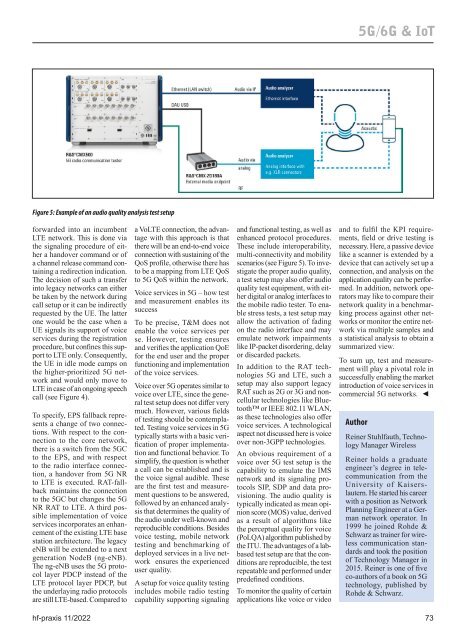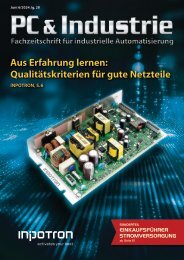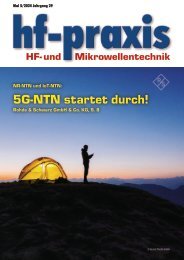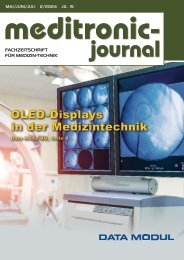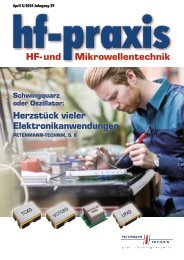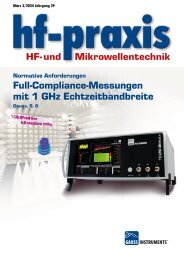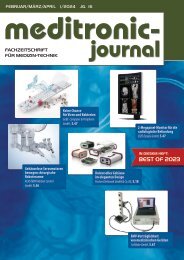11-2022
Fachzeitschrift für Hochfrequenz- und Mikrowellentechnik
Fachzeitschrift für Hochfrequenz- und Mikrowellentechnik
Erfolgreiche ePaper selbst erstellen
Machen Sie aus Ihren PDF Publikationen ein blätterbares Flipbook mit unserer einzigartigen Google optimierten e-Paper Software.
5G/6G & IoT<br />
Figure 5: Example of an audio quality analysis test setup<br />
forwarded into an incumbent<br />
LTE network. This is done via<br />
the signaling procedure of either<br />
a handover command or of<br />
a channel release command containing<br />
a redirection indication.<br />
The decision of such a transfer<br />
into legacy networks can either<br />
be taken by the network during<br />
call setup or it can be indirectly<br />
requested by the UE. The latter<br />
one would be the case when a<br />
UE signals its support of voice<br />
services during the registration<br />
procedure, but confines this support<br />
to LTE only. Consequently,<br />
the UE in idle mode camps on<br />
the higher-prioritized 5G network<br />
and would only move to<br />
LTE in case of an ongoing speech<br />
call (see Figure 4).<br />
To specify, EPS fallback represents<br />
a change of two connections.<br />
With respect to the connection<br />
to the core network,<br />
there is a switch from the 5GC<br />
to the EPS, and with respect<br />
to the radio interface connection,<br />
a handover from 5G NR<br />
to LTE is executed. RAT-fallback<br />
maintains the connection<br />
to the 5GC but changes the 5G<br />
NR RAT to LTE. A third possible<br />
implementation of voice<br />
services incorporates an enhancement<br />
of the existing LTE base<br />
station architecture. The legacy<br />
eNB will be extended to a next<br />
generation NodeB (ng-eNB).<br />
The ng-eNB uses the 5G protocol<br />
layer PDCP instead of the<br />
LTE protocol layer PDCP, but<br />
the underlaying radio protocols<br />
are still LTE-based. Compared to<br />
a VoLTE connection, the advantage<br />
with this approach is that<br />
there will be an end-to-end voice<br />
connection with sustaining of the<br />
QoS profile, otherwise there has<br />
to be a mapping from LTE QoS<br />
to 5G QoS within the network.<br />
Voice services in 5G – how test<br />
and measurement enables its<br />
success<br />
To be precise, T&M does not<br />
enable the voice services per<br />
se. However, testing ensures<br />
and verifies the application QoE<br />
for the end user and the proper<br />
functioning and implementation<br />
of the voice services.<br />
Voice over 5G operates similar to<br />
voice over LTE, since the general<br />
test setup does not differ very<br />
much. However, various fields<br />
of testing should be contemplated.<br />
Testing voice services in 5G<br />
typically starts with a basic verification<br />
of proper implementation<br />
and functional behavior. To<br />
simplify, the question is whether<br />
a call can be established and is<br />
the voice signal audible. These<br />
are the first test and measurement<br />
questions to be answered,<br />
followed by an enhanced analysis<br />
that determines the quality of<br />
the audio under well-known and<br />
reproducible conditions. Besides<br />
voice testing, mobile network<br />
testing and benchmarking of<br />
deployed services in a live network<br />
ensures the experienced<br />
user quality.<br />
A setup for voice quality testing<br />
includes mobile radio testing<br />
capability supporting signaling<br />
and functional testing, as well as<br />
enhanced protocol procedures.<br />
These include interoperability,<br />
multi-connectivity and mobility<br />
scenarios (see Figure 5). To investigate<br />
the proper audio quality,<br />
a test setup may also offer audio<br />
quality test equipment, with either<br />
digital or analog interfaces to<br />
the mobile radio tester. To enable<br />
stress tests, a test setup may<br />
allow the activation of fading<br />
on the radio interface and may<br />
emulate network impairments<br />
like IP-packet disordering, delay<br />
or discarded packets.<br />
In addition to the RAT technologies<br />
5G and LTE, such a<br />
setup may also support legacy<br />
RAT such as 2G or 3G and noncellular<br />
technologies like Bluetooth<br />
or IEEE 802.<strong>11</strong> WLAN,<br />
as these technologies also offer<br />
voice services. A technological<br />
aspect not discussed here is voice<br />
over non-3GPP technologies.<br />
An obvious requirement of a<br />
voice over 5G test setup is the<br />
capability to emulate the IMS<br />
network and its signaling protocols<br />
SIP, SDP and data provisioning.<br />
The audio quality is<br />
typically indicated as mean opinion<br />
score (MOS) value, derived<br />
as a result of algorithms like<br />
the perceptual quality for voice<br />
(PoLQA) algorithm published by<br />
the ITU. The advantages of a labbased<br />
test setup are that the conditions<br />
are reproducible, the test<br />
repeatable and performed under<br />
predefined conditions.<br />
To monitor the quality of certain<br />
applications like voice or video<br />
and to fulfil the KPI requirements,<br />
field or drive testing is<br />
necessary. Here, a passive device<br />
like a scanner is extended by a<br />
device that can actively set up a<br />
connection, and analysis on the<br />
application quality can be performed.<br />
In addition, network operators<br />
may like to compare their<br />
network quality in a benchmarking<br />
process against other networks<br />
or monitor the entire network<br />
via multiple samples and<br />
a statistical analysis to obtain a<br />
summarized view.<br />
To sum up, test and measurement<br />
will play a pivotal role in<br />
successfully enabling the market<br />
introduction of voice services in<br />
commercial 5G networks. ◄<br />
Author<br />
Reiner Stuhlfauth, Technology<br />
Manager Wireless<br />
Reiner holds a graduate<br />
engineer’s degree in telecommunication<br />
from the<br />
University of Kaiserslautern.<br />
He started his career<br />
with a position as Network<br />
Planning Engineer at a German<br />
network operator. In<br />
1999 he joined Rohde &<br />
Schwarz as trainer for wireless<br />
communication standards<br />
and took the position<br />
of Technology Manager in<br />
2015. Reiner is one of five<br />
co-authors of a book on 5G<br />
technology, published by<br />
Rohde & Schwarz.<br />
hf-praxis <strong>11</strong>/<strong>2022</strong> 73


